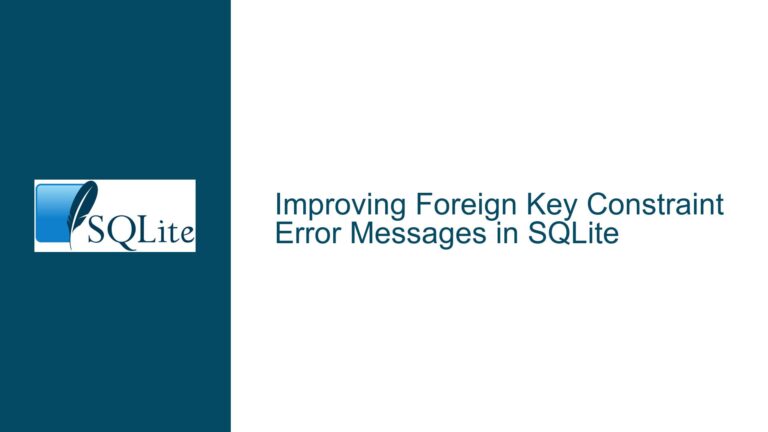Handling Multiple SQL Statements in Single Prepared Statement Execution
Understanding Multi-Statement Preparation Limitations in SQLite
SQLite’s architecture imposes fundamental constraints when attempting to prepare and execute multiple SQL statements through a single prepared statement interface call. While the SQLITE_PREPARE_MULTISTMT concept proposes bundling multiple commands (SELECT/INSERT/UPDATE/DELETE/WITH/RETURNING) into one Virtual Database Engine (VDBE) program, native SQLite3 APIs currently lack direct support for this workflow. The core challenge stems from SQLite’s statement preparation lifecycle – each sqlite3_prepare_v3() call typically processes only the first complete SQL statement in the input string, leaving subsequent statements unprocessed in the pzTail output parameter. This creates three critical operational constraints:
Transaction Scope Collision
When executing multiple data modification statements through iterative sqlite3_step() calls, all operations occur within a single implicit transaction unless explicitly managed through BEGIN/COMMIT statements. This violates the atomicity principle for individual business logic units when handling complex workflows containing both read and write operations. The SQLITE_PREPARE_MULTISTMT proposal attempts to address this by maintaining a unified transaction context across all bundled statements, but introduces new challenges in error recovery and partial execution scenarios.Parameter Binding Ambiguity
Named parameters (?NNN, :name, @name) and anonymous parameters (?) would share binding slots across all statements in the prepared batch under the proposed implementation. This creates namespace collisions when statements contain conflicting parameter identifiers, particularly dangerous when mixing DML operations from different business domains. For example, an INSERT statement’s :id parameter could inadvertently bind to a DELETE statement’s :id parameter if not properly scoped.Result Set Incompatibility
Mixed statement types (SELECT vs DML) in a multi-statement preparation would produce interleaved result sets and confirmation codes. The SQLITE_ROW return code from sqlite3_step() becomes ambiguous – does it indicate available rows from a SELECT or successful completion of a DML operation? Current SQLite APIs lack mechanisms to discern which specific statement generated the result, complicating client-side result processing logic.
Experimental implementations reveal that attempting to force multiple statements through standard preparation interfaces leads to cursor state corruption, particularly when statements contain temporary table operations or Common Table Expressions (CTEs). The SQLITE_SCHEMA error (error code 1) occurs frequently when later statements in the batch reference database objects modified by earlier statements, as SQLite’s schema version tracking isn’t designed for intra-preparation schema changes.
Common Pitfalls in Multi-Statement Execution Workflows
Developers attempting to implement batch statement processing often encounter four recurring failure patterns rooted in SQLite’s architectural constraints:
Implicit Transaction Lock Contention
SQLite’s locking protocol escalates from UNLOCKED→SHARED→RESERVED→EXCLUSIVE states during write operations. When executing multiple DML statements through repeated sqlite3_step() calls without intermediate transaction boundaries, the RESERVED lock persists until the final statement completes. This prevents concurrent readers from acquiring SHARED locks, effectively serializing all database access. The proposed SQLITE_PREPARE_MULTISTMT would exacerbate this by extending the locked duration across all batched statements.
Type Signature Mismatch in Parameter Binding
Batch operations combining statements with different parameter types (e.g., INSERT with INTEGER primary key and UPDATE with TEXT WHERE clause) trigger silent type conversions that may violate column affinity rules. Consider:
INSERT INTO users(id, name) VALUES(?, ?);
UPDATE profiles SET age=? WHERE username=?;
Binding (1, "Alice", 30, "alice2024") would succeed, but (NULL, "Bob", "thirty", "bob84") fails at the UPDATE’s age parameter despite the INSERT appearing first. SQLite’s error reporting lacks statement-level context, making debugging such failures non-trivial.
VDBE Program State Corruption
The SQLite Virtual Database Engine maintains register states and cursor positions between sqlite3_step() invocations. Mixed DML/DDL operations in batched statements can invalidate cursor references mid-execution. For example:
CREATE TEMP TABLE temp_data(id INTEGER);
INSERT INTO temp_data VALUES(1);
SELECT * FROM temp_data;
DROP TABLE temp_data;
SELECT * FROM temp_data; -- Invalid after DROP
Executing this sequence through a multi-statement preparation would fail on the final SELECT, but error reporting wouldn’t indicate which statement caused the failure. The SQLITE_ERROR result code (1) provides no context about the invalid schema access.
Memory Pressure from Unbounded Batches
Large statement batches processed through a single prepared statement retain all associated VDBE opcodes and result sets in memory until finalization. A batch containing 10,000 INSERT statements would maintain 10,000 insert cursors simultaneously, potentially exhausting SQLITE_CONFIG_HEAP memory limits. This contrasts with iterative prepare-step-finalize cycles that release resources after each statement.
Strategies for Reliable Multi-Statement Execution Management
To achieve robust batch processing within SQLite’s constraints, implement these proven patterns:
Parameterized Statement Chaining with Checkpoints
Wrap logical statement groups in explicit transactions and enforce memory/resource checkpoints:
sqlite3_exec(db, "BEGIN IMMEDIATE", 0, 0, 0);
sqlite3_stmt *stmt;
const char *sql_batch =
"UPDATE accounts SET balance = balance - ? WHERE id = ?;"
"UPDATE accounts SET balance = balance + ? WHERE id = ?;"
"INSERT INTO transfers(src, dst, amount) VALUES(?, ?, ?);";
rc = sqlite3_prepare_v3(db, sql_batch, -1, SQLITE_PREPARE_PERSISTENT, &stmt, NULL);
while (has_transactions) {
sqlite3_bind_int64(stmt, 1, debit_amount);
sqlite3_bind_int(stmt, 2, src_account);
sqlite3_bind_int64(stmt, 3, credit_amount);
sqlite3_bind_int(stmt, 4, dst_account);
sqlite3_bind_int(stmt, 5, src_account);
sqlite3_bind_int(stmt, 6, dst_account);
sqlite3_bind_int64(stmt, 7, transfer_amount);
while ((rc = sqlite3_step(stmt)) == SQLITE_ROW) {
// Process any SELECT results
}
if (rc != SQLITE_DONE) {
sqlite3_exec(db, "ROLLBACK", 0, 0, 0);
break;
}
sqlite3_reset(stmt);
// Commit every 100 transactions to manage locks
if (++tx_count % 100 == 0) {
sqlite3_exec(db, "COMMIT; BEGIN IMMEDIATE", 0, 0, 0);
}
}
sqlite3_finalize(stmt);
sqlite3_exec(db, "COMMIT", 0, 0, 0);
This approach provides:
- Explicit transaction boundaries for atomicity
- Batch size control through modulo commit intervals
- Prepared statement reuse with reset() instead of re-prepare
- Clean error recovery through savepoints
Selective UNION ALL for Read-Only Batches
For batches containing multiple SELECT statements, use UNION ALL to combine results while maintaining single-statement semantics:
SELECT id, name FROM users WHERE region = 'West'
UNION ALL
SELECT id, NULL FROM deactivated_users WHERE delete_after < CURRENT_DATE;
Adhere to these constraints:
- All SELECTs must have matching column counts
- Use NULL placeholders for missing columns
- Apply ORDER BY/LIMIT once at the statement end
- Include a synthetic batch_id column to identify source statements
External Batch Processor with Statement Caching
Implement a middleware layer that:
- Splits multi-statement input into individual SQL commands
- Prepares each statement separately using sqlite3_prepare_v3() with SQLITE_PREPARE_PERSISTENT
- Executes statements in sequence with transaction boundaries
- Caches prepared statements using (sql_hash, connection_id) as key
class StatementCache:
def __init__(self, db, size=100):
self.db = db
self.cache = LRUCache(size)
def execute_batch(self, sql_batch, params=()):
stmts = []
remaining = sql_batch
while remaining:
stmt, remaining = self._prepare(remaining)
stmts.append(stmt)
with self.db.transaction():
for stmt, stmt_params in zip(stmts, params):
stmt.reset()
stmt.bind_all(stmt_params)
while stmt.step() == sqlite3.ROW:
yield stmt.get_row()
def _prepare(self, sql):
if sql in self.cache:
return self.cache[sql], ''
stmt, remaining = self.db.prepare(sql)
self.cache[sql] = stmt
return stmt, remaining
SQLITE_CONFIG_MULTITHREAD with Connection Pooling
When using multiple threads for batch processing:
- Initialize SQLite in multi-thread mode via
sqlite3_config(SQLITE_CONFIG_MULTITHREAD) - Create a connection pool with 1 connection per 5 threads
- Use thread-local storage for prepared statements
- Set busy timeout with
sqlite3_busy_timeout(db, 5000)
Configure the connection pool with these parameters:
| Parameter | Value | Purpose |
|---|---|---|
| max_connections | CPU cores * 2 | Prevent contention on write-ahead log (WAL) |
| statement_cache_size | 50 | Balance memory usage vs. prepare overhead |
| wal_autocheckpoint | 1000 pages | Minimize checkpoint stalls during bulk operations |
| journal_mode | WAL | Allow concurrent reads during writes |
| synchronous | NORMAL | Risk partial writes on crash for improved batch performance |
Diagnostic Instrumentation
Embed telemetry in batch processing workflows:
#define LOG_STMT_PROGRESS(stmt) do { \
printf("Stmt %p: pc=%d op=%s cycles=%lld\n", \
stmt, \
sqlite3_stmt_status(stmt, SQLITE_STMTSTATUS_VM_STEP, 0), \
sqlite3_sql(stmt), \
sqlite3_cpu_time() - stmt->start_cycles); \
} while(0)
void execute_batch(sqlite3 *db, const char *sql) {
sqlite3_stmt *stmt;
const char *tail = sql;
while (tail && *tail) {
rc = sqlite3_prepare_v3(db, tail, -1, SQLITE_PREPARE_PERSISTENT, &stmt, &tail);
stmt->start_cycles = sqlite3_cpu_time();
while ((rc = sqlite3_step(stmt)) == SQLITE_ROW) {
LOG_STMT_PROGRESS(stmt);
}
if (rc != SQLITE_DONE) {
fprintf(stderr, "Batch failed at: %s\n", sqlite3_sql(stmt));
}
LOG_STMT_PROGRESS(stmt);
sqlite3_finalize(stmt);
}
}
This instrumentation helps identify:
- Statements causing VM step explosions (SQLITE_STMTSTATUS_VM_STEP)
- CPU time per statement
- Progress through multi-statement batches
Alternative Approaches When Native Batch Support Lacks
For workloads requiring atomic multi-statement execution:
- SQL Stored Procedures
Wrap batch operations in temporary views/triggers:
CREATE TEMP VIEW batch_ops AS
SELECT 1 AS id, 'CREATE TABLE tmp(a INT)' AS sql
UNION ALL
SELECT 2, 'INSERT INTO tmp VALUES(1)'
UNION ALL
SELECT 3, 'SELECT * FROM tmp';
WITH exec(sql) AS (
SELECT sql FROM batch_ops ORDER BY id
)
SELECT CASE
WHEN exec.sql LIKE 'SELECT%' THEN 'Result: ' || (SELECT json_group_array(a) FROM tmp)
ELSE 'Executed: ' || exec.sql
END
FROM exec;
- Application-Side Batching
Use deterministic UUIDs to correlate operations:
INSERT INTO batch_log(id, sql) VALUES
(hex(randomblob(16)), 'UPDATE accounts SET balance = balance - 100 WHERE id = 123'),
(hex(randomblob(16)), 'UPDATE accounts SET balance = balance + 100 WHERE id = 456');
SELECT sql FROM batch_log WHERE id IN (
SELECT id FROM batch_log
GROUP BY id
HAVING count(*) = 1 -- Ensure no duplicates
) ORDER BY rowid;
- Extension Loader with Custom VFS
Implement a SQLite extension that intercepts prepare() calls:
static int hook_prepare(
sqlite3 *db,
const char *zSql,
int nByte,
sqlite3_stmt **ppStmt,
const char **pzTail
) {
if (strstr(zSql, "--batch")) {
return process_batch(db, zSql, ppStmt);
}
return SQLITE_OK;
}
sqlite3_auto_extension((void(*)(void))hook_prepare);
This architecture allows custom batch processing logic while maintaining compatibility with standard SQLite clients.
By systematically applying these patterns – from parameterized statement chaining to diagnostic instrumentation – developers can achieve reliable multi-statement execution within SQLite’s current constraints. The key lies in balancing atomicity requirements with resource management, while leveraging SQLite’s extensibility to bridge functionality gaps until native multi-statement support matures.






